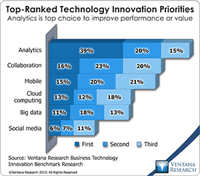Epicor used its recent user group conference to explain its strategic direction and product roadmap. The company is the result of multiple mergers of business software corporations over the past 15 years; its target customers are midsize companies and midsize divisions of larger organizations. Its most significant products are Epicor (ERP software aimed mainly at manufacturing and distribution companies) and Activant Solutions (software for small and midsize retailers, including a point-of-sale...
Read More
Topics:
Microsoft,
Mobile,
SaaS,
Sales,
Customer Experience,
ERP,
HCM,
Human Capital,
Office of Finance,
Operational Performance Management (OPM),
communications,
Dynamics AX,
Dynamics GP,
Dynamics NAV Dynamics SL,
Epicor,
Sage Software,
UI,
Unit4,
Analytics,
Business Analytics,
Cloud Computing,
Collaboration,
Business Performance Management (BPM),
CFO,
Customer Performance Management (CPM),
Financial Performance Management (FPM),
FinancialForce,
HR,
Infor,
Supply Chain Performance Management (SCPM),
Workday,
Workforce Performance Management (WPM),
Social,
Financial Performance Management,
FPM,
Plex
I recently received an update from ERP software vendor Epicor, my first since it was acquired in May 2011 by Apax Partners, a private equity company, and simultaneously merged with Activant, an ERP and point-of-sale software company serving midsize retailers and distributors. In my view, taking the company private is a good idea since it will have to make ongoing investments that would not have been treated kindly by the stock market. Bringing Epicor and Activant together (and perhaps adding...
Read More
Topics:
Big Data,
Microsoft,
Mobile,
SAP,
Social Media,
ERP,
Operational Performance Management (OPM),
Dynamics,
Epicor,
Sage,
Analytics,
Business Analytics,
Business Collaboration,
Business Mobility,
Cloud Computing,
Oracle,
Business Performance Management (BPM),
CRM,
Financial Performance Management (FPM),
Infor,
Supply Chain Performance Management (SCPM),
Workforce Performance Management (WPM),
Social,
Financial Performance Management
As Workday continues to expand and the likelihood of its IPO becomes a more frequent topic of discussion, so does the movement of ERP systems to the cloud. Thus far, only a minority of companies have chosen to put their ERP and accounting systems in the cloud, but the numbers are growing and there’s evidence of success. NetSuite, for example, reported a 26 percent increase in its revenues to $145 million in the nine months up to Sept. 30, 2011. To be sure, this is not close to Salesforce.com’s...
Read More
Topics:
Microsoft,
Sales,
ERP,
NetSuite,
Office of Finance,
Operational Performance Management (OPM),
Dynamics,
Epicor,
Lawson,
QAD,
Cloud Computing,
IBM,
Oracle,
Business Performance Management (BPM),
Financial Performance Management (FPM),
Infor,
Supply Chain Performance Management (SCPM),
Workforce Performance Management (WPM),
financial software,
Intacct,
PeopleSoft,
Software











